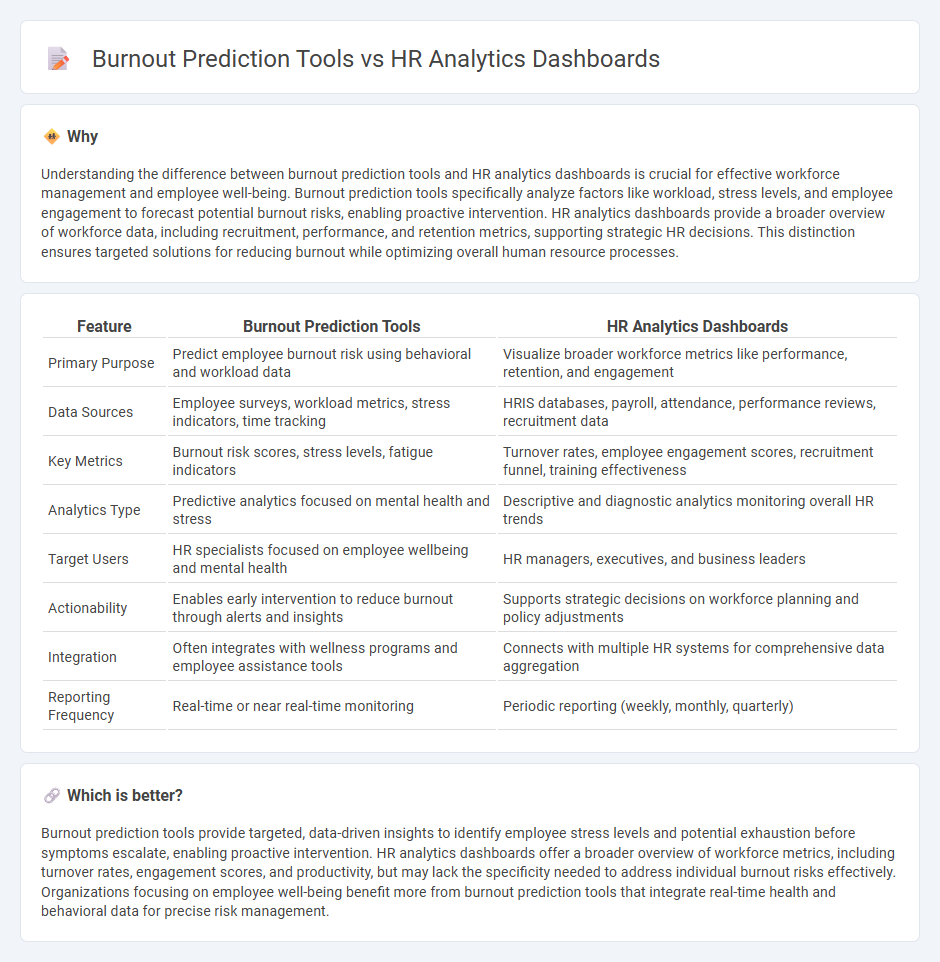
Burnout prediction tools utilize machine learning algorithms to identify early signs of employee stress and disengagement, enabling proactive intervention to maintain workforce well-being. HR analytics dashboards aggregate real-time data on performance, attendance, and employee feedback to provide comprehensive insights into workforce trends and potential risks. Explore how integrating burnout prediction with HR analytics dashboards can transform employee management and enhance organizational productivity.
Why it is important
Understanding the difference between burnout prediction tools and HR analytics dashboards is crucial for effective workforce management and employee well-being. Burnout prediction tools specifically analyze factors like workload, stress levels, and employee engagement to forecast potential burnout risks, enabling proactive intervention. HR analytics dashboards provide a broader overview of workforce data, including recruitment, performance, and retention metrics, supporting strategic HR decisions. This distinction ensures targeted solutions for reducing burnout while optimizing overall human resource processes.
Comparison Table
| Feature | Burnout Prediction Tools | HR Analytics Dashboards |
|---|---|---|
| Primary Purpose | Predict employee burnout risk using behavioral and workload data | Visualize broader workforce metrics like performance, retention, and engagement |
| Data Sources | Employee surveys, workload metrics, stress indicators, time tracking | HRIS databases, payroll, attendance, performance reviews, recruitment data |
| Key Metrics | Burnout risk scores, stress levels, fatigue indicators | Turnover rates, employee engagement scores, recruitment funnel, training effectiveness |
| Analytics Type | Predictive analytics focused on mental health and stress | Descriptive and diagnostic analytics monitoring overall HR trends |
| Target Users | HR specialists focused on employee wellbeing and mental health | HR managers, executives, and business leaders |
| Actionability | Enables early intervention to reduce burnout through alerts and insights | Supports strategic decisions on workforce planning and policy adjustments |
| Integration | Often integrates with wellness programs and employee assistance tools | Connects with multiple HR systems for comprehensive data aggregation |
| Reporting Frequency | Real-time or near real-time monitoring | Periodic reporting (weekly, monthly, quarterly) |
Which is better?
Burnout prediction tools provide targeted, data-driven insights to identify employee stress levels and potential exhaustion before symptoms escalate, enabling proactive intervention. HR analytics dashboards offer a broader overview of workforce metrics, including turnover rates, engagement scores, and productivity, but may lack the specificity needed to address individual burnout risks effectively. Organizations focusing on employee well-being benefit more from burnout prediction tools that integrate real-time health and behavioral data for precise risk management.
Connection
Burnout prediction tools utilize HR analytics dashboards to visualize real-time employee stress indicators, workload, and engagement metrics, enabling proactive intervention. HR analytics dashboards aggregate diverse data sources such as absenteeism rates, overtime hours, and employee feedback, providing predictive insights into burnout risks. Together, these technologies enhance workforce well-being by allowing human resources professionals to identify at-risk employees and implement targeted retention strategies.
Key Terms
**HR analytics dashboards:**
HR analytics dashboards aggregate employee data to visualize key performance indicators such as turnover rates, absenteeism, and productivity metrics, enabling HR teams to make data-driven decisions. These dashboards integrate real-time data from various HR software systems to provide insights into workforce trends and employee engagement levels. Explore how HR analytics dashboards can transform strategic planning and operational efficiency in human resources.
Key Performance Indicators (KPIs)
HR analytics dashboards track KPIs such as employee turnover rates, absenteeism, and productivity metrics to provide comprehensive insights into workforce performance. Burnout prediction tools concentrate on early indicators like stress levels, workload, and engagement scores to identify employees at risk of burnout. Explore how integrating these tools can enhance organizational well-being and optimize workforce management.
Data Visualization
HR analytics dashboards provide comprehensive data visualization by integrating metrics like employee performance, engagement, and turnover rates into interactive charts and graphs to inform strategic decisions. Burnout prediction tools specialize in visualizing stress indicators and workload patterns using heatmaps and trend lines to identify at-risk employees early. Explore how these data visualization approaches can transform workforce management and employee well-being.
Source and External Links
11+ HR dashboard examples & best practices - HR dashboards consolidate key HR data and KPIs into interactive, mobile-responsive visual tools that enable quick trend spotting, real-time KPI tracking, and automated reporting for smarter HR decisions.
HR Dashboard: 3 Examples, Functions, and KPIs - An HR dashboard provides a centralized visual overview of essential HR metrics such as turnover, recruitment pipeline, engagement scores, and performance reviews to support data-driven talent management.
HR Dashboard Examples: Ultimate Guide for Modern HR ... - Common HR dashboards include recruitment & hiring dashboards and turnover & retention dashboards, with KPIs like time-to-fill, offer acceptance rate, attrition rate, and cost of employee turnover to optimize HR strategies.
 dowidth.com
dowidth.com